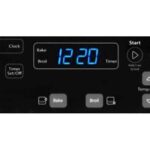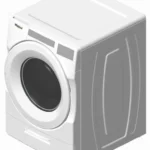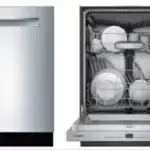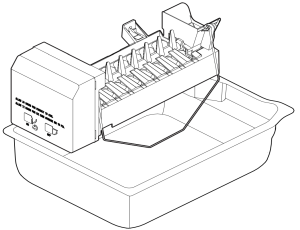

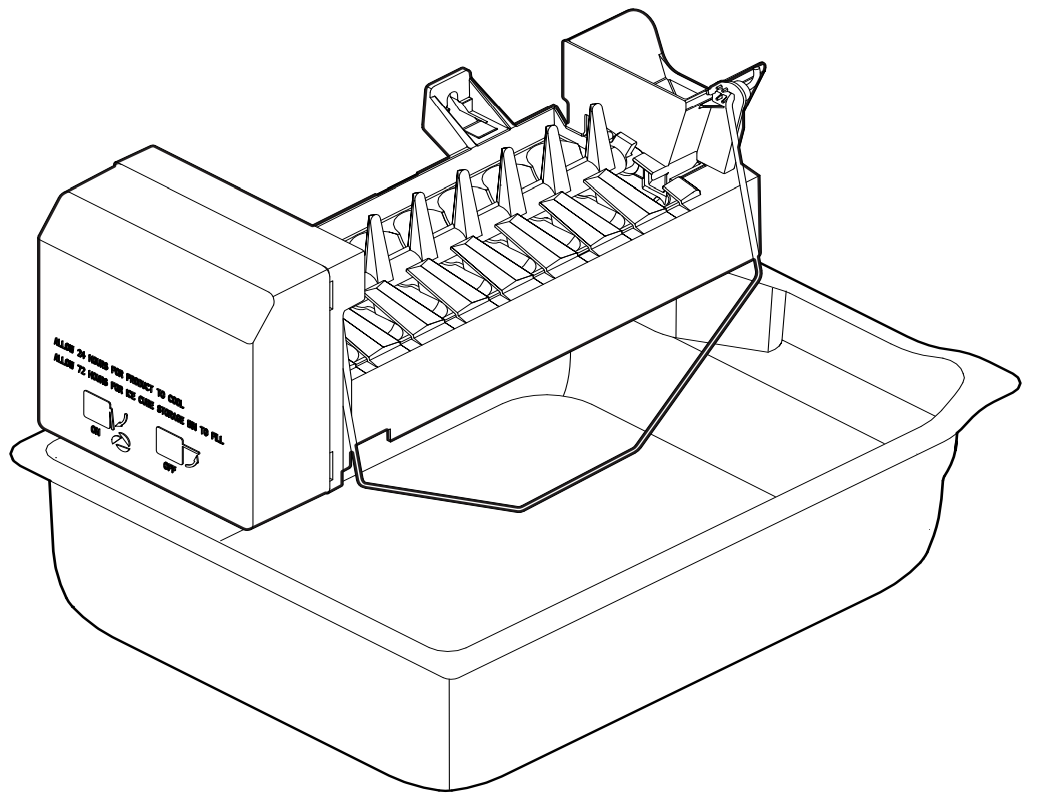
W11518243A
Requesting Assistance or Service
If you need assistance contact your dealer, or call the Whirlpool Experience center toll-free, 1-800-253-1301, 24 hours a day.
Important Information
The following information is used throughout this installation Guide. Read it carefully so you are familiar with it.
Your safety and the safety of others are very important.
We have provided many important safety messages in this manual and on your appliance. Always read and obey all safety messages.






All safety messages will tell you what the potential hazard is, tell you how to reduce the chance of injury, and tell you what can happen if the instructions are not followed.
- This Installation Guide gives you complete instructions on how to install the Ice Maker Kit in your refrigerator-freezer and connect a water line to it. Please read the guide thoroughly and follow the instructions exactly as described. Also, make sure that you observe all of the “safety” instructions.
- IMPORTANT: A qualified service technician must install the waterline and ice maker.
- Before you start to install your Ice Maker Kit, you will have to purchase a copper tubing kit that contains a “Regular Valve and Clamp Assembly” (for refrigerators with an automatic ice maker, or self-filling trays). The kit contains all of the hardware necessary to connect your ice maker to the water supply. You can purchase one at most hardware or plumbing supply stores.
NOTE: Do not use piercing-type or 3/16″ shut-off valves. They reduce the flow of water to the ice maker and are easily clogged.
Do not use polyethylene tubing to connect the ice maker to the waterline. Use only 1/4″ (O.D.) copper tubing.
CUSTOMER INSTALLATION IS NOT WARRANTED BY THE REFRIGERATOR OR ICE MAKER MANUFACTURER.
Before You Begin
Tools
Gather required tools and parts before starting installation. Read and follow the instructions provided with any tools listed here.
| 1. Regular screwdriver 2. Phillips screwdriver 3. 7/16″ and 1/2″ open-end wrenches (or an adjustable wrench) 4. Pliers |
5. 1/4″ nut driver 6. Level 7. Ruler 8. Electric screwdriver |
Installation notes
For each set of steps shown, refer to the diagram immediately beside or below the text for clarification. Some illustrations may contain labels A, B, or C, which are referenced in associated steps. Some illustrations also contain “DETAILS.” DETAILS are contained in bubbles alongside the larger illustration.
Install the parts as instructed in each step and corresponding illustration.
Components
Remove the contents from the shipping carton and set them on a table where they can be easily identified and located.
Do not discard any of the packing material until all required parts are identified.
| QTY | DESCRIPTION |
| 1 | Ice Maker Assembly |
| 2 | Jumper Harness |
| 1 | Ice Pan |
| 1 | Fill Tube Assembly |
| 1 | Water Line Cover |
| 5 | 518″ screws |
| 1 | Water Line Clamp |
| 1 | Compression Nut & Sleeve |
| 2 | Water Valve |
| 1 | Adhesive Clip |
| 1 | Splash Guard |
| 1 | Tube Guide |
| 1 | Air Diverter |
| 1 | Installation Instructions |
Installing the Ice Maker
Making preparations
- Pull the refrigerator away from the wall so that you can easily access the rear panel.
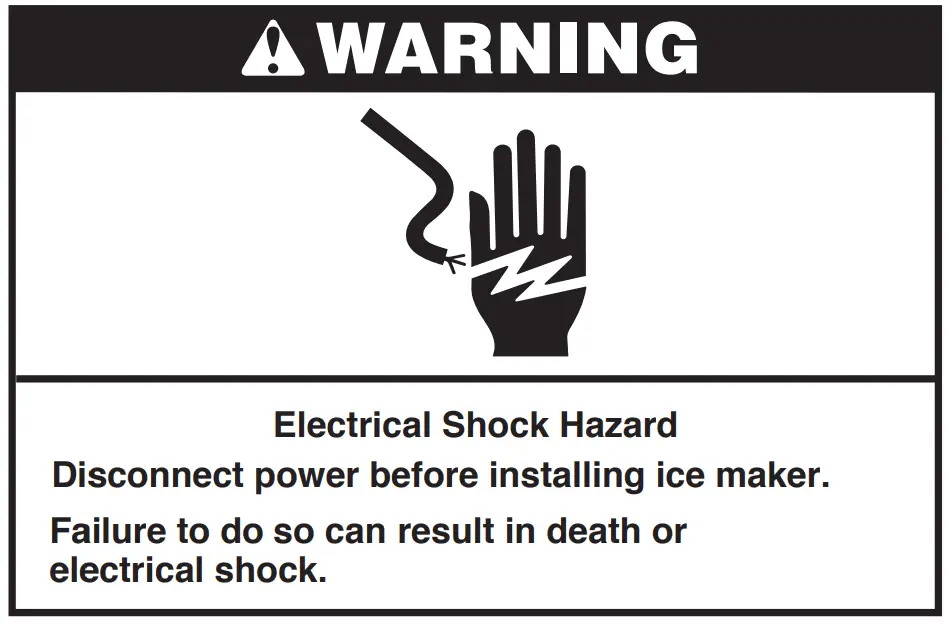
- Unplug the refrigerator or disconnect power.
- Open the freezer door and remove all of the food items from inside the freezer compartment.
- Remove all baskets, shelves, ice cube trays, and the ice cube tray holder (if necessary, refer to your User Guide for the procedure). Set these items aside.
NOTE: The work areas are shown below.
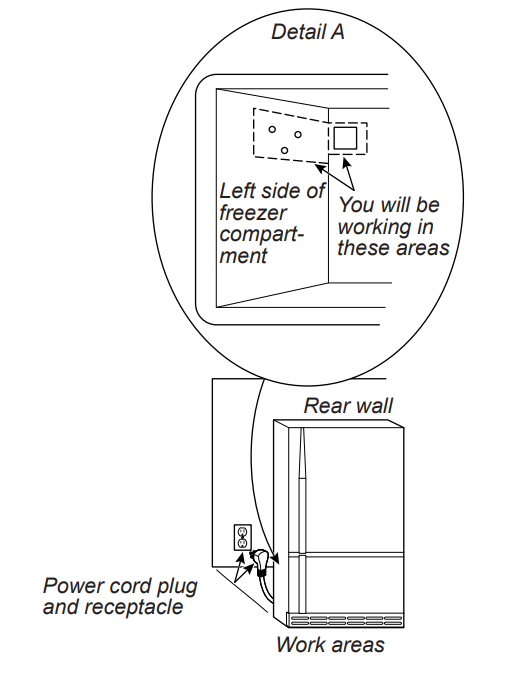
- Remove the water connection cover from the back freezer wall by inserting a flat blade screwdriver into each of the slots on the face of the cover and prying it off.
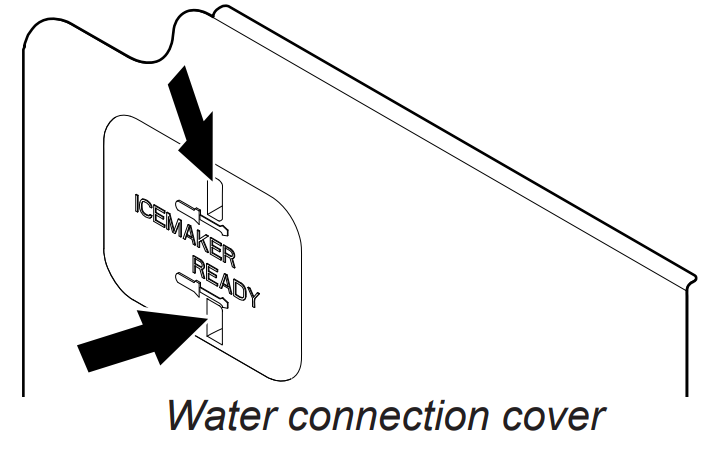
- If present, locate the tube inlet sticker on the back of the unit and remove it. Cut through any tape under the sticker.
- Insert the fill tube through the hole in the back of the unit with the spout facing down.
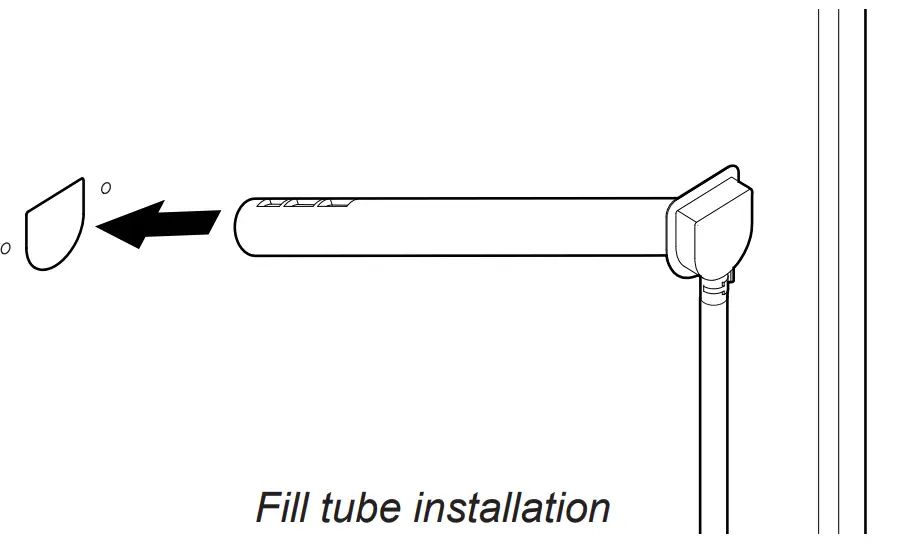
- Install water line cover over the fill tube using two of the 5/8″ screws provided in the kit. An electric screwdriver may be used.
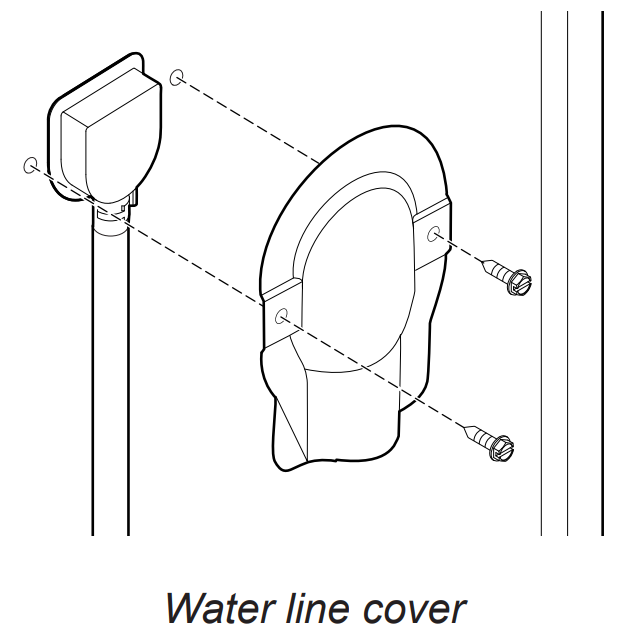
Mounting the Water Valve
NOTE: When using this kit to replace an existing ice maker or valve, the new valve and the new ice maker from this kit must both be used.
- Remove valve cover screw (A) using 1/4″ nut driver. Retain screw. Detach harness from the inner side of cover by removing the clip. Discard cover.
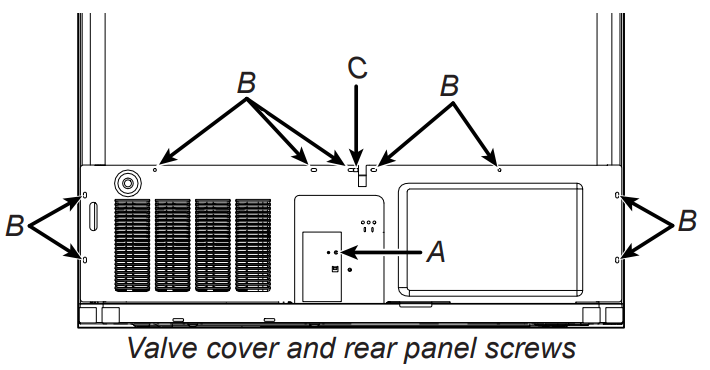
- Remove 6-9 screws (B) from the rear panel. Remove strain relief from the slot (C). Remove panel.
- Locate the 2-pin water valve connector inside the machine compartment. Determine which of the two included water valves has the appropriate connection to mate with this connector. Discard the other water valve.
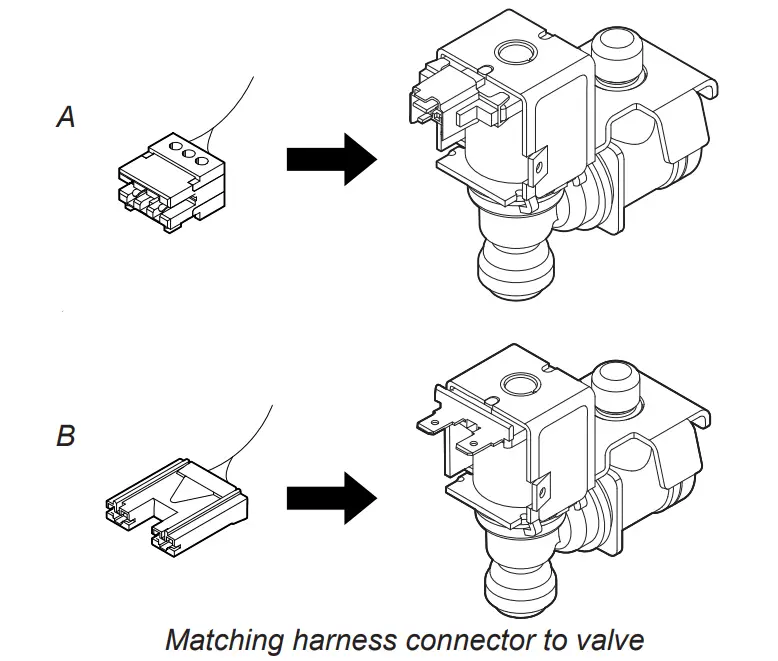
- Insert the top of the valve chosen in step (3) through a slot in the rear panel, then rotate so the bracket is flat against the panel.
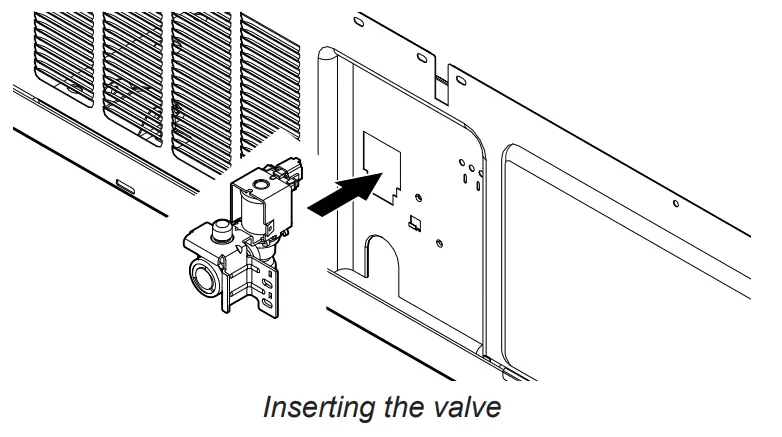
- Assure water valve bracket is placed into retainer tab (A) and secure to panel with screw (B) removed in step 1.

- Slide water line guide into rear panel slot below the valve, as shown in the illustration.
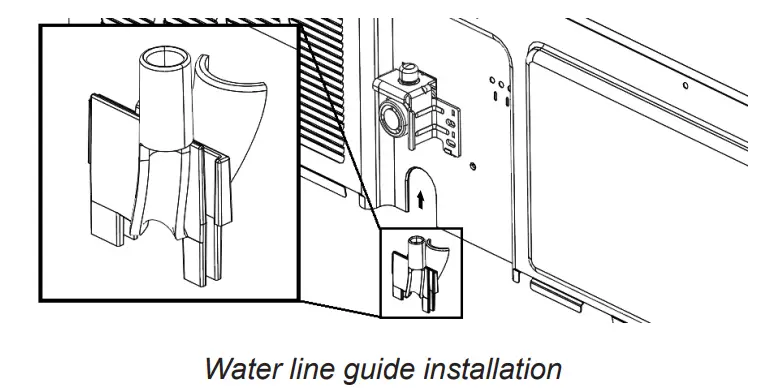
- Insert water line from fill tube into water line guide opening.
Loop tube under the bottom of rear panel and insert into water valve nozzle.
NOTE: Make sure the tube is fully inserted into the valve, past the first marking on the tube.
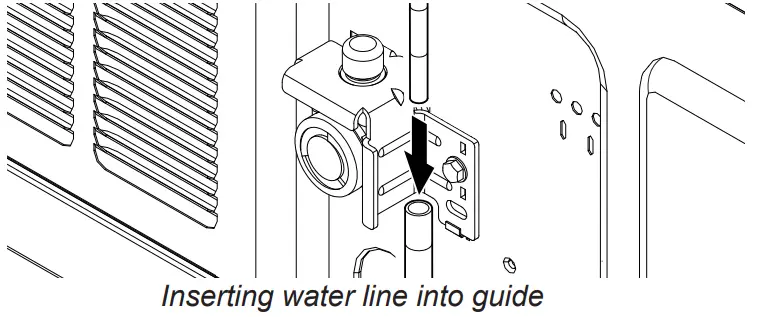
- Pull excess water line tubing taut against the U-channel (A) in the water line guide.
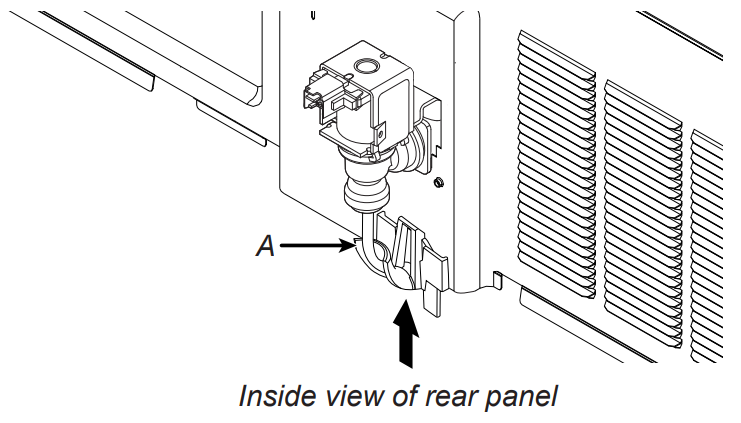
- Snap plastic shield over water valve nozzle.
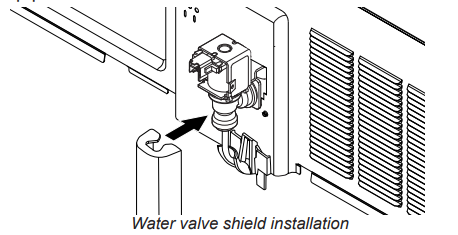
- Plug the connector from the refrigerator machine compartment into connector/terminals on the water valve.
- Insert strain relief clip-on power cord back into the slot in rear panel and reinstall panel using 6-9 screws removed in step 2 (refer to the illustration in step 2 for screw locations B and strain relief location C).
- Secure excess water line tubing to the cabinet with the small plastic adhesive clip included in the ice maker kit. Position clip (A) approximately halfway between fill tube and valve.

Mounting the Ice Maker
NOTE: When using this kit to replace an existing ice maker or valve, the new valve and the new ice maker from this kit must both be used.
- Screw two 5/8″ ice maker mounting screws into upper holes present in the left wall of the freezer section. Leave head out approximately 3/8″ for the slot in the icemaker hanger to lip over the screws. Remove Phillips screw (A) if present and discard.
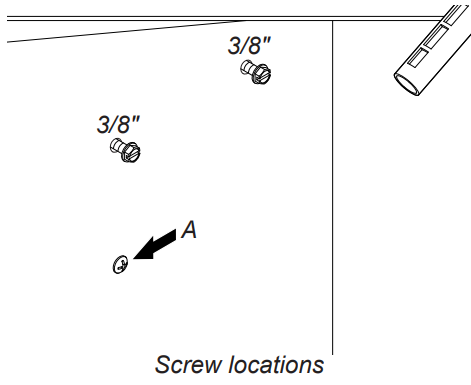
- Determine which of the two provided jumper harnesses mate with the connector housing in the back of your freezer.
A 5-pin housing requires the jumper with the matching 5-pin plug (A). A 4-pin housing requires the jumper with the matching 4-pin plug (B).
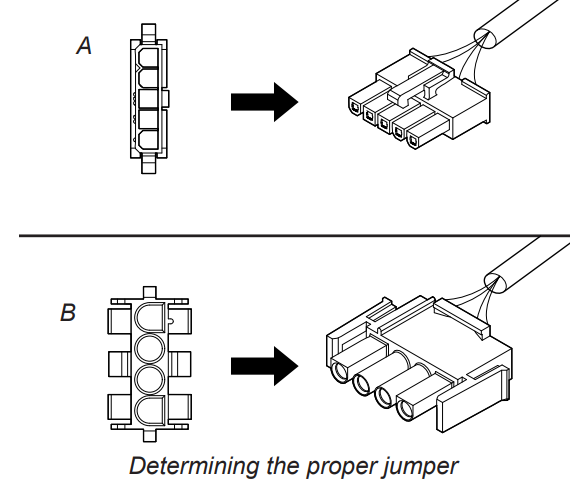
- Connect the jumper chosen in step 2 to the harness on the ice maker. Confirm the locking fingers snap into place. Route jumper over the guide (A) and through the wire clip (B) on the side of the ice maker.
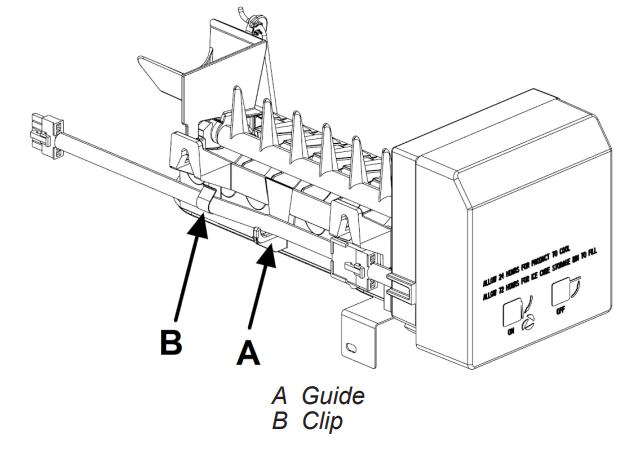
- Connect the other end of the jumper to the housing in the back of your freezer, making sure the locking fingers snap in place.
- Slide ice maker hangers over screws.
IMPORTANT: Make sure the top of each screw touches the bottom of the hanger on the ice maker (see illustration). This ensures the ice maker is oriented correctly.

- Tighten down top mounting screws, making sure the hangers remain flush against the screws as the screws are tightened.
Insert the remaining mounting screw into the bottom of the ice maker and tighten.
Note: The top front screw is slightly lower than the rear screw, so the ice maker should tilt slightly so that water flows from the fill cup.
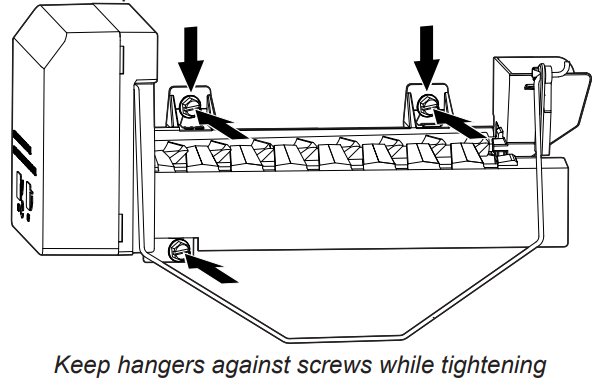
- Confirm water fill tube is aligned with the fill cup on the ice maker. If needed, loosen mounting screws to correct alignment of the ice maker with a fill tube, then repeat steps 5-6.
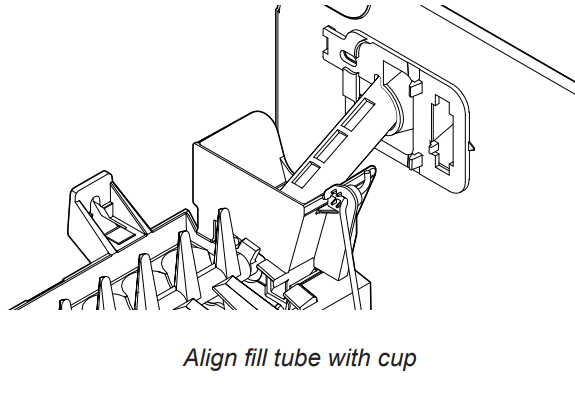
- Route ice maker wire harness and jumper away from moving parts and fill tube. Confirm the bail arm can move freely between the lowered and horizontal positions.
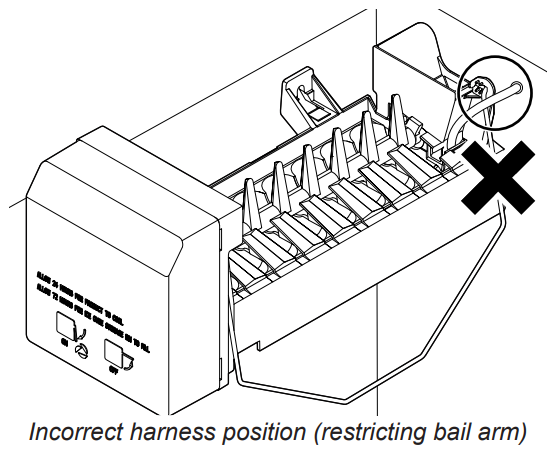
- Install the air diverter by inserting 2 tabs into openings (A) in the freezer air grille then snapping the clip into the slot (B).
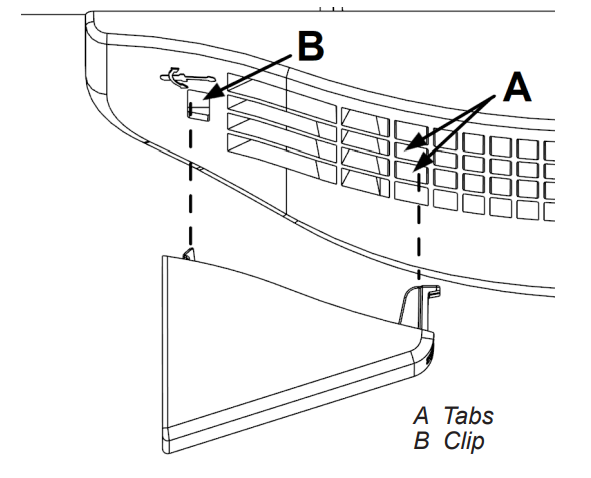
- If your ice maker has an ON / OFF rocker switch, flip the switch to the OFF (O) position until the water connection is complete.
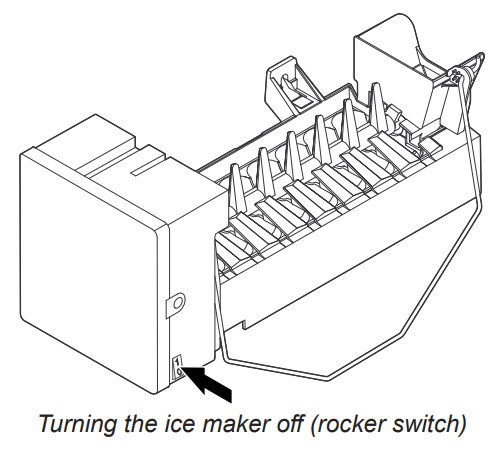
- If your ice maker does not have a rocker switch, raise the wire shut-off arm to the OFF (up) position until the water connection is complete.
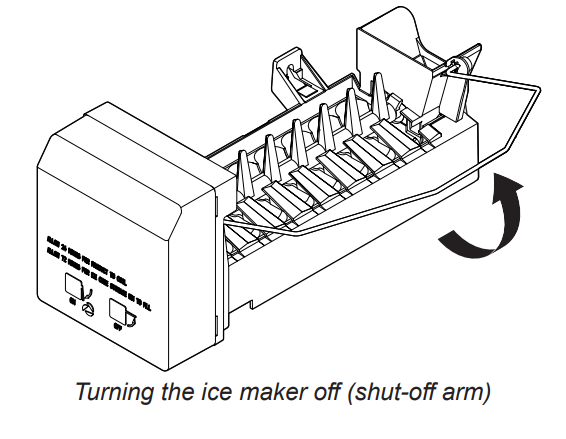
Read all directions before you begin.
IMPORTANT:
- Connect to potable water supply only.
Do not use water that is microbiologically unsafe or of unknown quality without adequate disinfection before or after the system. Systems certified for cyst reduction may be used on disinfected waters that may contain filterable cysts. - Plumbing must be installed in accordance with the International Plumbing Code and any local codes and ordinances.
- Copper and PEX tubing connections from the household water line to the refrigerator are acceptable and will help avoid off-taste or odor in your ice or water. Check for leaks.
- If PEX tubing is used instead of copper, we recommend the following part numbers: W10505928RP (7 ft [2.14 m] jacketed PEX), 8212547RP (5 ft [1.52 m] PEX), or W10267701RP (25 ft [7.62 m] PEX).
- Install tubing only in areas where temperatures will remain above freezing.
Tools Needed:
Gather the required tools and parts before starting installation.
- Flat-blade screwdriver
- 7/16″ and 1/2″ open-end wrenches or 2 adjustable wrenches
- 1/4″ nut driver
NOTE: Do not use a piercing-type or 3/16″ (4.76 mm) saddle valve, which reduces water flow and clogs easier.
Connect to Water Line
IMPORTANT: If you have turned the refrigerator on before the water was connected, turn off the ice maker.
- Unplug the refrigerator or disconnect power.
- Turn off the main water supply. Turn on the nearest faucet long enough to reduce water pressure in the waterline.
- Use a quarter-turn shut-off valve or the equivalent, served by a 1/2″ household supply line.
NOTE: To allow sufficient water flow to the refrigerator, a minimum 1/2″ (12.7 mm) size household supply line is recommended.
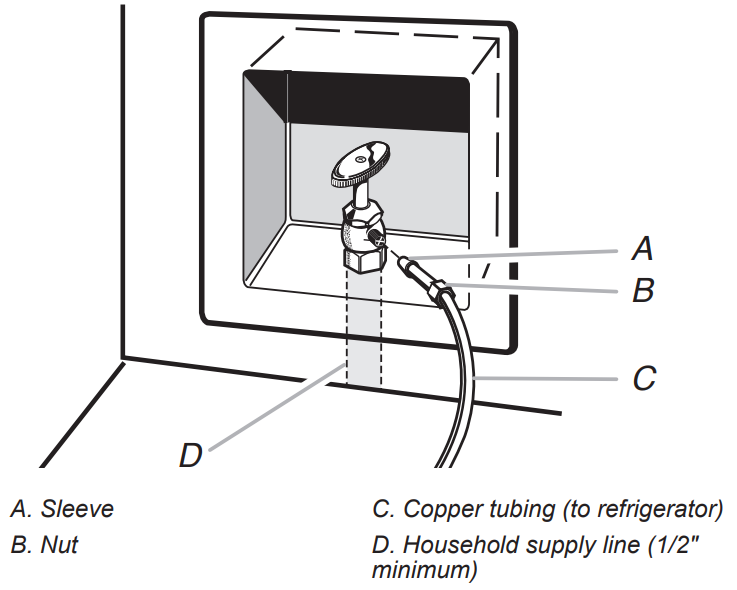
- Now you are ready to connect the copper tubing to the shut-off valve. Use 1/4″ (6.35 mm) O.D. (outside diameter) soft copper tubing to connect the shut-off valve and the
refrigerator. - Ensure that you have the proper length needed for the job. Be sure both ends of the copper tubing are cut square.
- Slip compression sleeve and compression nut onto copper tubing as shown. Insert the end of the tubing into the outlet end squarely as far as it will go. Screw compression nut onto outlet end with an adjustable wrench. Do not overtighten.
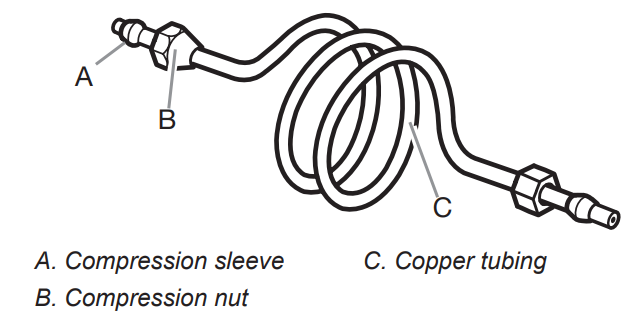
- Place the free end of the tubing into a container or sink and turn on the main water supply to flush out tubing until water is clear. Turn off the shut-off valve on the water pipe.
Note: Always drain the water line before making the final connection to the inlet of the water valve to avoid possible water valve malfunction. - Bend the copper tubing to meet the water line inlet, located on the back of the refrigerator cabinet as shown. Leave a coil of copper tubing to allow the refrigerator to be pulled out of the cabinet or away from the wall for service.
Connect to Refrigerator
Follow the connection instructions specific to your model.
- Remove the plastic cap from the water valve inlet port. Attach the copper tubing to the valve inlet using a compression nut and sleeve as shown. Tighten the compression nut. Do not overtighten. Confirm copper tubing is secure by pulling on copper tubing.
- Create a service loop with the copper tubing. Avoid kinks when coiling the copper tubing. Secure copper tubing to the rear panel with a “P” clamp, using the original screw in the panel slot above the valve.
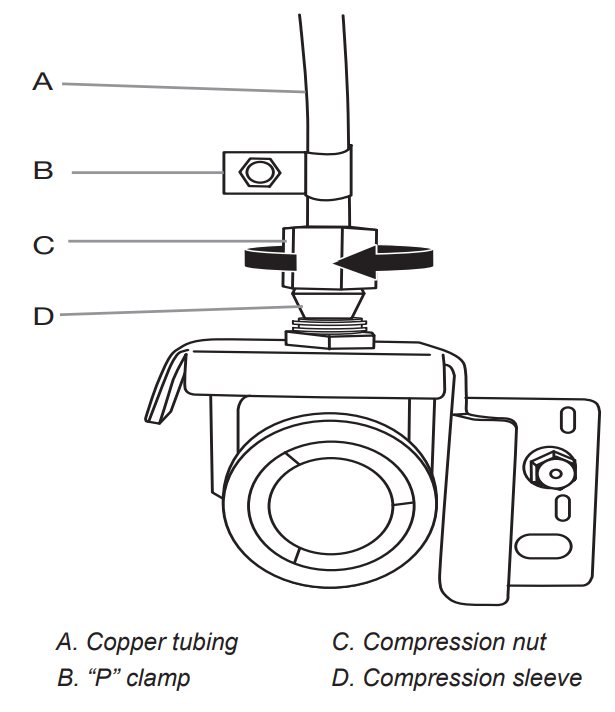
- Turn on the water supply to the refrigerator and check for leaks.
Correct any leaks.
Connecting the power/ Leveling the unit
![]()
- Plug the power cord into its AC outlet, and push the refrigerator back against the wall.
- Place a level on top of the refrigerator cabinet. If you need to relevel, follow the procedure outlined in your refrigerator’s User Guide.
Starting the Ice Maker
- Reinstall the freezer baskets into the freezer compartment (if necessary, refer to your User Guide for the procedure).
- Wash out the ice pan, then place it in the upper basket, directly under the ice maker. Slide the pan as far back as it will go.
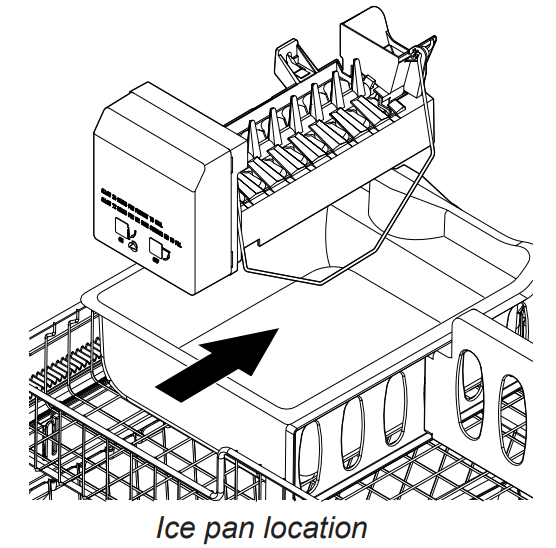
- Move the ON/OFF rocker switch to the ON (I) position. Press & hold the freezer light switch. Depress the service diagnostic button for 3 seconds. You should observe the heater turning on, the motor completing one cycle, and water filling near the end of the cycle. Once a successful cycle completes and the motor stops in the resting position, let go of the freezer light switch.
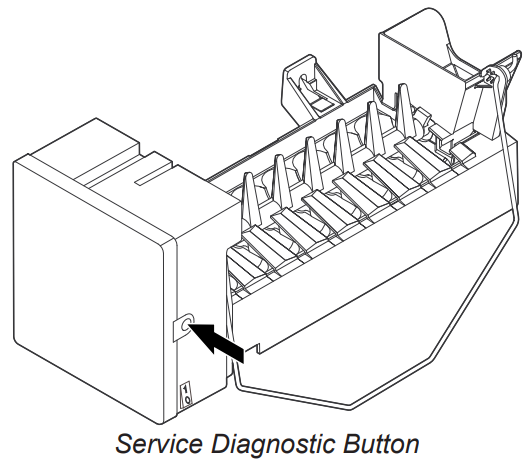
- Cycle the rocker switch OFF (O) then ON (I) again. Close the freezer door. The ice maker will begin to make ice within 24 hours.
Service Diagnostic Button
NOTE: The remaining steps only apply to ice makers without a rocker switch. - IMPORTANT: Make sure freezer lights are on and the freezer door switch remains open when performing this step.
Manually rotate ejector fingers 60 degrees towards a vertical orientation. To avoid damaging the ice maker, ejector fingers should only be rotated in a clockwise direction (see illustration).
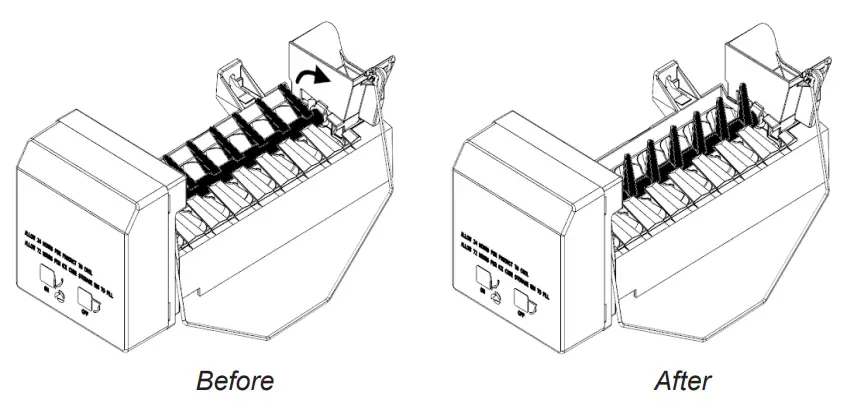
- Lower wire shutoff arm to the ON (down) position and close the freezer door. The ice maker will begin to make ice within 24 hours.

- Confirm installation by holding down the freezer door switch.
You should observe the following:
• Ejector fingers rotating as the cycle begins
• Water filling near the end of the cycle
• Ejector fingers stopping in the horizontal position (2-10 seconds after water fill completes)
NOTE: Usually it takes approximately 24 hours for the ice maker to begin producing ice. Once the ice is available, you may notice that it has an “off-taste”. If this happens, make two or three batches of ice and discard them. After that, the “off-taste” should be gone. If you have any problems, refer to the “Troubleshooting” section.
Troubleshooting
Operational notes
- The Ice Maker valve contains a flow washer that acts as a pressure regulator to control the water flow. For the Ice Maker to work properly, the water pressure in your home must be between 20 and 120 pounds per square inch (psi). If you encounter problems with your Ice Maker’s ability to produce ice, call your water utility company and have the water pressure checked.
- The Ice Maker’s water valve is equipped with two strainers: a plastic basket type and a wire-mesh screen. Both of these can be cleaned by turning off the water and disassembling the water valve (your service center should be able to provide this service). If local water conditions require periodic cleaning, or if you use a well as a water source, you should consider installing a second water strainer in the waterline. You can obtain a water strainer from your local appliance dealer.
Troubleshooting chart
The following chart lists several common problems that could occur with your Ice Maker.
| PROBLEM | CAUSE |
| One or more of the following sounds is heard: • Buzzing • Trickling water • Thud (clatter of ice) |
The water valve is operating. Ice is being dumped into the ice bin. |
| Ice tastes stale. | The ice is old. Make a new batch. |
| Water in Ice Maker overflows. | The refrigerator or Ice Maker is not level. If the Ice Maker still overflows after leveling, turn off the Ice Maker’s water supply at the shut-off valve and turn the switch “off”; then contact your local service center. |
| Not enough ice. | It will take 72 hours to fill the ice bucket. The ice maker will make ice every 2 to 3 hours. For more ice, adjust the freezer control for a colder setting. |
| Ice-making has stopped. | Make sure that the water valve is Open.
The water valve screen is clogged (contact your local service) |
NOTES

Used under license in Canada.
W11518243A
05/21
